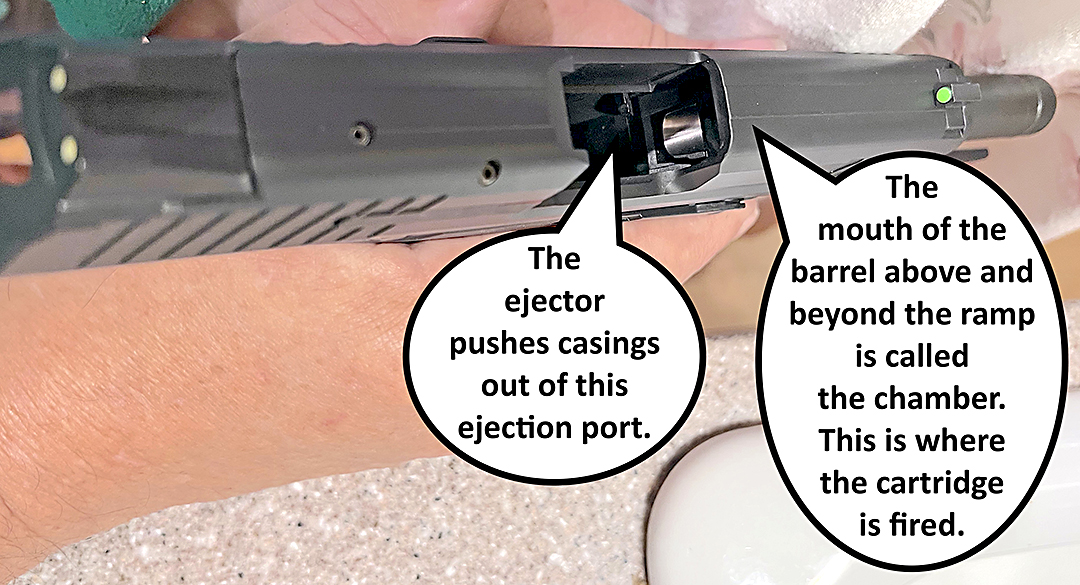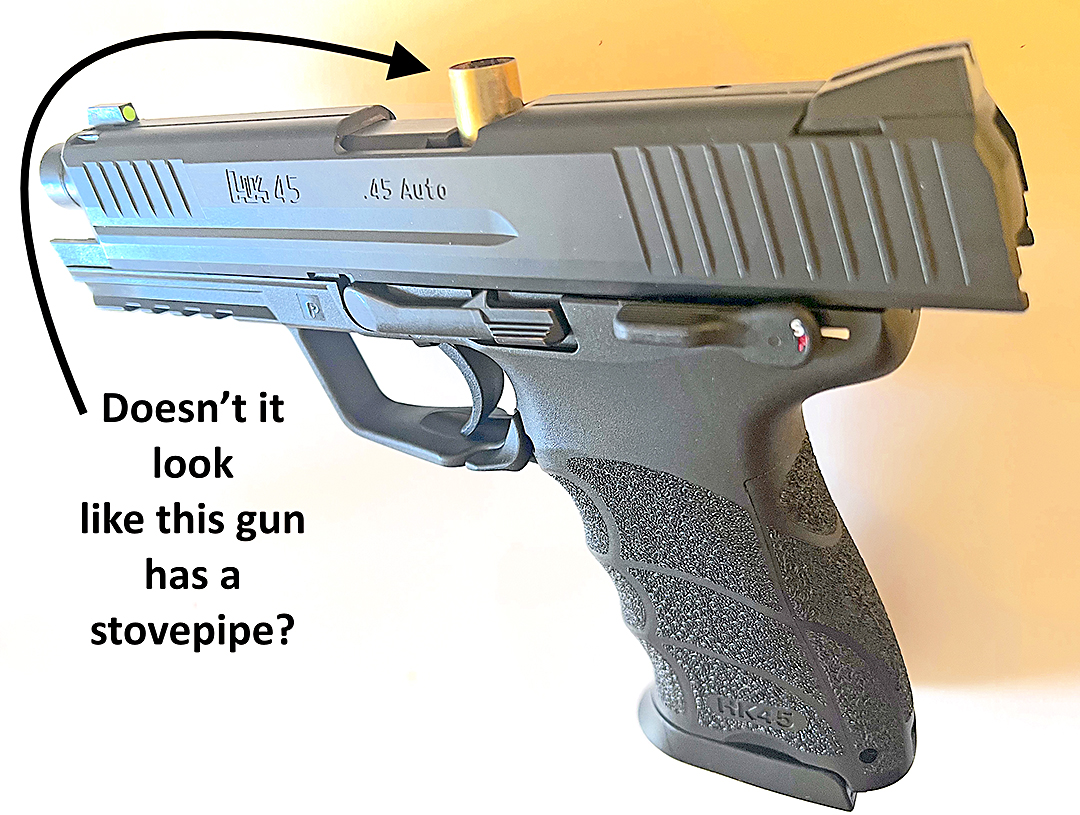WHAT TO DO WHEN SOMETHING’S WRONG

By MARJ LAW


“Oh, no! Something’s wrong with my semi-automatic handgun! It didn’t go off!”
What’s Newbie to do next?
The good news is there’s always a deputy at the WCSO range to help. But wait! Don’t grab your gun and go running to the office.
First, keep that muzzle pointing downrange. Yes, we’ve said it before many times, but sometimes, when things don’t go right, we kinda forget what we know. So, point it downrange.
Next, drop the magazine onto the counter (called a shooting bench) in front of you. Look into the ejection port. Is the round lodged there? If so, rotate the gun so that gravity will allow it to fall out. Great. The gun is empty and you can reload your magazine and try again. What? You can still see the end of the casing lodged in the chamber? Oops. If you’re new to shooting and you see that the round is lodged here, then it’s time to get help.
Place the gun on the shooting bench with muzzle downrange. If you have an experienced friend nearby, ask for help. If you’re not sure you trust anyone there to fix the problem, leave your gun on the bench. Ask your friend to keep an eye on your gun while you go to the office seeking assistance from the deputy. So, what are some of the likely problems you might experience?
A big three are:
• Failure to feed,
• Failure to extract, and
• Failure to eject.
Let’s talk about a failure to feed.
Several things can cause a failure to feed. One is that you may have a problem with your magazine. Especially if the gun is old, the spring in the magazine may be worn or defective. That spring may not be able to push the round into the gun.
Also, if the lips at the mouth of the magazine have been crushed, damaged, or worn, rounds might not be able to feed through the magazine. This is more likely to occur with an older gun, or one that has been shot a lot or abused. I don’t see magazine problems often at all, but then, the guns I’ve been shooting are generally less than 15 years old.
Another scenario is what we call a “nose dive.” When you pull back your slide, you see that the round is still sitting inside the ejection port, with its nose facing downward at the base of the ramp. Why didn’t it go up the ramp and into the barrel?
This again can be caused by an old, damaged or cheap magazine. It happens. Not too often, though.
Another failure to feed can be caused by putting the wrong caliber round in the gun. I’ve seen a person put a 9mm round in a 40-caliber handgun. The 9 might fit in the magazine, but the gun wasn’t made for it, so the 9mm round won’t fit and feed correctly.
Either scenario: a bad magazine or an incorrect caliber round can either not feed into the gun or can become hung up before it gets to the ramp.
In the above cases, the round has experienced a failure to feed.
Failure to extract.
You fire your gun. The bullet, which is the projectile part of the round, flies out of the gun. Your extractor has grabbed the outer rim of the round’s casing and yanks the casing backwards into the ejection port. Then it’s the ejector’s job to shove the casing out of the gun.
Extractor and ejector sound very similar, but think of the extractor as a yanker and an ejector as a heaver. The extractor yanks the casing back and the ejector acts to heave that casing out of the gun.
So, if the extractor, (yanker) does not grab the casing out of the chamber and back into the ejection port, then you’ve got a failure to extract. If you pull the slide back, all you’ll see is the back of the casing at the rear of the barrel.
Failure to eject.
Now the extractor has grabbed the casing and pulled it back into the ejection port. If the ejector (the heaver) doesn’t push the casing out of the ejection port, you’ve got a failure to eject. Is the ejector defective? It’s possible.
Darn ejector bar could be broken, weak or worn down. Now that the end of the casing can’t run into the ejector bar, the casing can’t be pushed out of the port. This failure to eject prevents the slide from closing and your gun can’t load a new round.
Your extractor itself may cause a failure to eject if it is worn, broken, or encrusted with shooting residue. If it can’t move up and grab the casing firmly, that casing can end up not leaving the chamber.
Failure to eject and stovepipes.
You may get a “stovepipe.” That’s when your gun has fired and the bullet has flown out of it. However, the casing may be stuck upright or cockeyed in the ejection port. This is pretty obvious because then the slide cannot return to battery and you can see that casing peeking out of the ejection port. This does happen more often than most other problems. It’s probably because so many things can cause stovepipes: not just one happening.
Who’s at fault here? Let’s look at parts, ammo and you. Yikes.
• It’s the darn ejector. Bent, worn, broken? Yep. That ejector isn’t there to push out the casing, so it can stovepipe or sit cockeyed in the ejection port.
• It’s the ammunition.
It’s old, defective, worn, or lacking gunpowder. It lacks the oomph needed to cycle the gun strongly. Then the extractor may not be able to move the casing firmly backwards. Which means the ejector won’t be able to perform his job, either. The casing remains in the port in some sort of angle keeping the slide from returning to its original position.
• It’s a dirty gun.
The grooves where the slide moves along the frame are full of grease and shooting residue. Now the slide can’t move freely.
• It’s a dirty gun.
The extractor’s got goop in its hook so it can’t grab the casing properly. The casing comes into the port half-heartedly, but not with enough oomph to hit the ejector so it can fly out.
• It’s a “dry gun.”
Lack of lubrication could cause dragging and prevent the slide from moving properly against the frame.
• It’s a recoil spring.
A recoil spring too weak to allow the slide to move back as it should, so the extractor and ejector can’t do their jobs.
• It’s you “limp-wristing” the gun.
As a new shooter, this is the most common thing that will be said to you. It’s not the gun: it’s you. You don’t have a firm grip on the gun. If you had a better grip, this wouldn’t happen.
Don’t let this happen. Learn how to hold your gun very firmly. When you’re fairly new to shooting, and especially if you are a gal, if there’s a stovepipe, a guy will accuse you of limp-wristing.
If a limp-wristing does cause a stovepipe, this is what happens: You don’t hold the grip firmly when it fires. Instead, your hands give and go backwards as the gun fires. Now the slide and gun are going in the same direction. The slide does not whack firmly against the frame, so it doesn’t have the power to eject the empty casing, causing the casing to be either trapped parallel in the ejection port or stovepiped.
So, Newbie, learn to grip your gun properly. Limp-wristing is a patronizing term. Don’t let it be applied to you.
Failure to feed, to extract and to eject are major gun difficulties. As a new gun owner, the deputy at the WCSO range is there to help you. Often, more experienced gun owners are only too happy to assist as well.
As you become more experienced, you’ll be more and more able to detect what goes wrong with your gun.
Then your only concern is how well you punch out that x-ring.
Marj Law is the former director of Keep Wakulla County Beautiful who has become an avid shooter in retirement.
